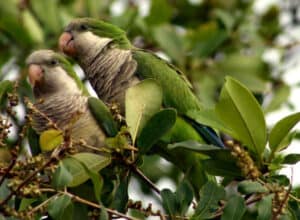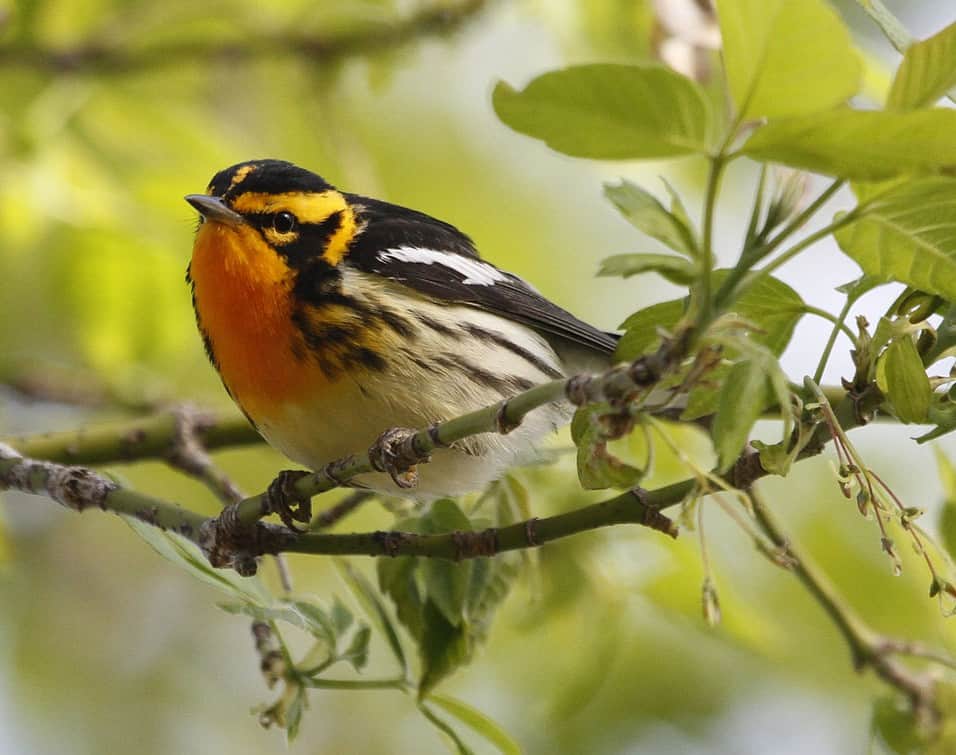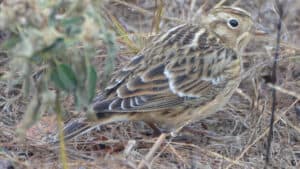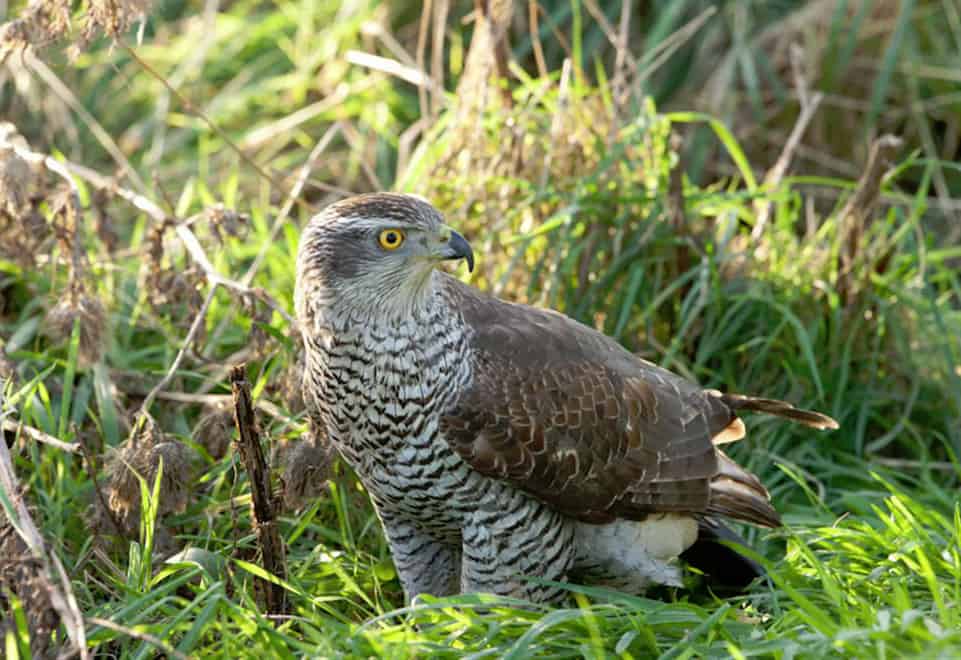1. American White Pelican

A relatively new addition to Illinois avifauna, the American white pelican now migrates through the state along large rivers, sometimes stopping on lakes and other large reservoirs to rest and feed. Birders have observed as many as 4,500 pelicans at one time gathered along the Illinois River.
This mostly white bird with black wings has a long, large orange bill and throat pouch, which it uses to scoop up and swallow fish. It stands about 5 feet tall and has a 9-foot-long wingspan. In all plumages, the white pelican has a naked orange patch around its eye and bright orange-yellow legs and feet.
White pelicans don’t dive to feed like brown pelicans do, but they have their own interesting way to search for a meal. They gather in lines to corral schools of small fish into groups by flapping their large wings onto the water’s surface. A pelican gulps water and fish with its large pouch, then it squeezes the water out of the sides of its mouth as the fish head into its stomach.
Some white pelicans may linger in Illinois long after the rest of the spring migrants have left, and birders speculate that someday this species may begin breeding in the prairie state.
The best places to find large flocks of white pelicans include Lake Chautauqua and the Mark Twain National Wildlife Refuge, as well as along the Illinois River in southwestern Illinois. The best months are March, April, September, and October.
2. Mississippi Kite

Once more widespread in Illinois, the Mississippi kite now lives mostly in the southern part of the state and only during breeding season. You can find this bird beginning in late April through early September, when it leaves to return to its South American wintering grounds.
This graceful raptor stands about 14 inches tall, and when it flies its wingspan is 35 inches. The adult has a dark gray back with a long, dark tail. Its head and underparts are lighter gray. Look closely at a perched bird and you might see some chestnut color at the tips of the wings. Juveniles are darkish brown on the back and have streaks across the underparts.
In flight this kite displays long, pointed wings and a square tail as it dips and turns, catching its insect prey prey in midair. The kite prefers river bluffs and bottomland forests and often nests in large cottonwood trees overlooking water. Kites nest singly or in small colonies. Both adults assume parenting duties building a flimsy, stick nest, taking turns incubating and then feeding the young until they are fully grown. An adult may bring food to its one-to-three nestlings once every five minutes.
The Mississippi kite gracefully hawks insects in the air and occasionally takes bats in flight or lizards. A drive through Thebes, Illinois, along the river in May could reward you with the sight of dozens of Mississippi kites hawking insects in the air
Search for kites along river bluffs and bottomland forests at the Union County Conservation Area and the Fort Kaskaskia State Historic Site in spring, summer and early fall.
3. Monk Parakeet

Parakeets in Illinois? Actually yes. In fact, the native Carolina parakeet once plied the Prairie State’s skies along with the passenger pigeon. Today both are extinct, but Illinoisans have a new parakeet, though not native, to observe. This South American species was introduced in the 1960s to North America by the exotic pet industry. Small colonies have survived and now even breed successfully in the Illinois.
About 12 inches tall, the monk parakeet has green on its back, white on its throat, yellow-green on its belly and blue on its wings. Its bright colors add pleasure to a dreary winter’s day.
The monk parakeet survives the cold winters by feeding on ornamental berries and partaking of food from feeders. In addition, the species builds colonies of large nests made of sticks and grass, often atop transformers, where the birds huddle in winter to keep warm.
In summer, the parakeets raise six to eight young in their huge nests. Juveniles may help raise a second brood before autumn comes.
Humans made several attempts to get rid of the monk parakeets, but failed. Today Illinoisans accept this species as part of the state’s avifauna, marveling at its adaptability and raucous colors.
The best place to search for small flocks of parakeets are in the Hyde Park and Jackson Park regions of Chicago, at Addison and Armitage Roads in the town of Addison, and at the grain elevator in the town of Carlyle in southern Illinois. Small breeding colonies seem to be expanding south and north from Chicago.
4. Greater Prairie-Chicken

One of Illinois’ most endangered birds, the greater prairie-chicken exhibits an unusual and spectacular courtship. Beginning in March, male prairie-chickens gather on leks or booming grounds in short grasslands. Then they begin their dance to declare dominance over other males and attract nearby females. The males lift their tails, lower their wings, and inflate their yellow-orange air sacs, which produce a loud booming noise. They may also run around quickly and leap into the air.
Standing 18 inches tall, the adult male greater prairie-chicken has a heavily barred brown back with a rufous and buff belly on a plump body. The edge of its tail is black, and when in full courtship attire, it has bright yellow eye combs or tufts of feathers. Long, pointy black ear tufts add to the almost comical appearance of this bird. The female is mostly heavily barred brown.
Once abundant statewide, the prairie-chicken can now only be found on about 3,000 acres of grassland in southeastern Illinois in or near the Prairie Ridge State Natural Area. A few bird clubs offer annual trips to watch the chickens from viewing blinds in March and April when you can observe courtship displays from a safe distance.
The state Department of Natural Resources is working to save this species from extinction. Illinois’ prairie-chicken numbers have declined so much due to habitat loss as well as the introduction of ring-necked pheasants that officials have had to bring prairie-chickens from other states to Illinois to maintain a viable gene pool.
5. Northern Saw-whet Owl

On a brisk winter day, several birders peer inside a group of cedars at Morton Arboretum in Lisle, Illinois, to view a seemingly tame and tiny owl, the northern saw-whet. The 7-inch tall bird winks its yellow eyes at them, unaffected.
This bird has found its daytime roosting place and there it will remain until dusk when it swoops in a nearby field to catch a mouse or other small prey.
The northern saw-whet owl migrates through Illinois and some stay for the winter, often remaining in the same roost for days or months if not disturbed. Its back is brown, spotted with white, its belly is streaked with rust, and a light facial disc frames its eyes.
Searching for this species in winter takes patience as well as knowledge about its mysterious ways. After eating, owls cough up pellets, a matted blend of bone and fur they can not digest. Search at the base of evergreens—especially cedars, white pines and yews—for the pellets as well as whitewash. If you find these clues, look up into the tree and you may see a saw-whet owl peering down at you.
Fairly reliable spots to find northern saw-whet owls in winter include the Morton Arboretum in northern Illinois, the Middlefork State Fish and Wildlife Areas in central Illinois and Eldon Hazlet State Park in southern Illinois. Or join a local Audubon Society or birding club on one of their annual owl prowl trips.
Northern saw-whet owls depart Illinois in March and early April for their northern coniferous woodland breeding grounds.
6. Pileated Woodpecker

The pileated woodpecker’s loud jungle-like scream compels you to chase after it in the deep woods until you can find it. The largest of Illinois’ woodpeckers, the 16-inch-tall, crow-sized pileated displays a bright red crest, yellow eyes, and a deep black body. The male sports a red moustache.
This woodpecker lives year-round in Illinois. It needs at least 100 acres of mature woods with some dead or dying trees in which to breed. That kind of habitat is scarce in northeastern Illinois, so your best chance of seeing one is to hike the Illinois and Mississippi River valleys or the Shawnee National Forest in southern Illinois and listen for its call and deep, slow hammering on its favored sycamores, beeches, and tulip poplars.
The pileated hammers at the base of rotting trees to search for carpenter ants and beetle larvae. It has a long, sticky tongue that it uses to extract ants and grubs from deep inside its excavated feeding holes. After the hunt, the pileated leaves behind long, oval holes, which serve as a telltale sign of its presence. Sometimes you can find pileateds on the ground pecking away at rotting logs to get at the ants within.
Pileated woodpeckers begin nesting in Illinois in April, excavating a hole up to 2 feet deep. When they are 15 days old, the young peer out of the nest hole and give soft calls when they see their parents returning with food. They fledge in about four weeks and spend the rest of the summer foraging for food with their parents.
7. Prothonotary Warbler

The prothonotary warbler symbolizes the swamplands of southern Illinois. Where there is stagnant water and trees, you’ll often hear the loud zweet zweet zweet zweet zweet song of this brightly colored warbler throughout spring and summer.
The male has a plain, golden-yellow head set off by large black eyes, a greenish back, blueish wings and tail, and a yellow throat and belly. The female is a lighter version of the male.
The 6-inch-tall prothonotary is one of only two North American warblers that raises young in cavities. Tree holes will do, but so, too, will artificial cavities such as an old tin cup hanging in a barn that’s near water. The prothonotary won’t choose nests sites near fast flowing bodies of water, but prefers the quieter, river backwaters and swamplands.
Recent studies in southern Illinois show that the prothonotary readily nests in makeshift nest boxes made of milk cartons and attached to trees in swamps.
In southern Illinois, the prothonotary can be ubiquitous in the proper habitat; but the farther north you go, the more difficult it is to find this species. One reliable northern Illinois spot during summer includes the McHenry Dam portion of Moraine Hills State Park, where officials have erected artificial nest boxes along the Fox River backwaters. In southern Illinois, you can search for these birds as early as late March at Cypress Creek National Wildlife Refuge and Pine Hills-La Rue Ecological Area. By September, the prothonotary has left for its Central and South American winter home.
8. Blackburnian Warbler

Birders never tire of seeing the Blackburnian warbler; and those seeing it for the first time can’t help expressing amazement at the indescribable burnt-orange color of the male’s throat.
This warbler breeds in the coniferous forests of northeastern United States, parts of Canada and the Appalachian Mountains. Illinoisans get to see it during migration, usually throughout May. When it passes through Illinois in September heading for its South American wintering grounds, the male loses his fiery brilliance and is more difficult to identify.
But in spring, you’ll note not only this 5-inch tall bird’s brilliant throat but also the orange and black face markings. The male Blackburnian also has a dark back; large, white wing patch; whitish underparts, and streaks on its sides. Females, immatures, and nonbreeding (fall) males typically have duller yellow-to-orange throats and breasts and streaks on the back, with two small white wing bars.
Warblers and other songbirds choose various niches in which to feed, so they can share the same tree. The Blackburnian prefers the higher parts of the trees, particularly oaks, but often likes exposed perches for singing, which give birders good views.
Look for this warbler (a fairly common migrant) anywhere you find migrating songbirds. Especially good spots are along Water Plant Road at Atwood Ridge and Hamburg Hill in southern Illinois, the Des Plaines River corridor in Lake and Cook Counties (Ryerson Woods, Wright Woods, and Half Day Road), and the Magic Hedge at Montrose Harbor.
9. Bobolink

Ask any Illinois birder and they’ll probably tell you the bobolink is one of their favorite birds. They just can’t resist the male’s bubbly, energetic song combined with his reverse tuxedo plumage.
About 7 inches tall, the male bobolink has a black belly, throat, and face and white back (the opposite of a man’s white shirt and black jacket in a tuxedo). A lemon-yellow crown that extends to the nape finishes off the dapper look. Females, immatures and nonbreeding males look like sparrows with a dark eye line and a light central crown stripe.
You’ll find the males in spring and early summer flying over grasslands and hayfields, singing on the wing. The female, camouflaged by her grass-like colors, builds a cup nest in a shallow depression on the ground. When the young hatch in about two weeks, the female feeds them seeds and small insects. The males continue to defend territory with their songs until the young have fledged.
The bobolink may well be one of the fastest-declining songbirds in the nation. Illinois volunteers and scientists have helped create better habitat for these birds. One of the best places in the state to see this species spring through fall is at the Orland Grasslands, a Cook County Forest Preserve holding near Orland Park. A major restoration project there has helped bobolinks and other rare grassland breeders. Midewin National Tallgrass Prairie near Joliet also offers habitat for these birds, which will accept non-native hayfields in which to breed.
10. Smith’s Longspur

Birders statewide and beyond covet a glimpse of the handsome and secretive Smith’s longspur, most often seen in Illinois during March and April.
The sparrow-sized bird appears in various plumages as it migrates through the Prairie State in spring. About 7 inches tall, the breeding-plumaged Smith’s longspur sports a black crown along with a golden-orange throat, breast, underparts, and collar. Its black-and-white facial pattern and its white wing spots are striking. Females and males still wearing winter plumage show subtler colors with some faint streaking on the head and sides
This longspur feeds on foxtail seeds among cornfields while migrating through Illinois in spring. Farmers who leave foxtail remnants in with their corn stubble over the winter instead of spraying their fields with pesticides offer feeding spots for this longspur as it travels north to breeding grounds along the Hudson Bay coast.
A ground feeder, the Smith’s longspur often hides among rows of corn stubble. But sometimes a small group will take to the sky right in front of you, flashing their white outertail feathers and giving a warbling spring song or a buzzy call.
In Illinois, the Smith’s longspur rarely mingles with the more common and migratory Lapland longspur, although both species frequent the same fields. Nonbreeding male Laplands have whitish throats and breeders have black throats.
The Illinois Ornithological Society leads a trip in April each year searching for the Smith’s longspur and other migrants. Rarely if ever has a trip participant left without a good spotting-scope view of a male Smith’s longspur in full breeding plumage.




